

“诗意想象”朱锫建筑个展在柏林Aedes建筑论坛顺利开幕

2024年2月16日,朱锫建筑个展“诗意想象:建筑与传统价值的交织 “Poetic Imagination:Interweaving Architecture With Traditional Values”在德国柏林Aedes Architecture Forum顺利开幕。这是朱锫继2017年个展“会心 Mind Scape”之后,在这个久负盛名的国际建筑空间举办的第二次个人建筑展览。
On February 16, 2024, Zhu Pei’s architectural solo exhibition “Poetic Imaginations: Interweaving Architecture With Traditional Values” successfully opened at the Aedes Architecture Forum in Berlin, Germany. This is Zhu Pei’s second solo exhibition at this prestigious international architecture gallery, following his 2017 solo exhibition “Mind Landscapes”.
本次展览以建筑模型、创作手稿、实景视频等多种媒介方式展示了朱锫工作室近年来的六件代表作品,包括景德镇御窑博物馆、马家窑遗址博物馆与观景建筑、景德镇紫晶国际会舍、OCT艺术中心、杨丽萍表演艺术中心、以及寿县文化艺术中心,全方位展现了在迥异的自然条件与文化背景之中,建筑如何在地的扎根与创造,将来自自然与传统的美学与智慧,交织呈现在当代的诗意空间之中,以多元的实践进一步探索和充实了朱锫“自然建筑”思想。
This exhibition displays six representative works of Studio Zhu Pei in recent years through various media such as architectural models, creative manuscripts, and live videos, including the Jingdezhen Imperial Kiln Museum in Jiangxi, the Majiayao Ruins Museum and Observatory in Gansu, and the Zijing International Conference Camp in in Jiangxi, Shandong Zibo OCT Art Center in Shandong, Yangliping Performing Arts Centre in Yunnan, and Shou County Culture and Art Center in Anhui, all comprehensively demonstrate how architecture can take root and create in place amidst vastly different natural conditions and cultural backgrounds, intertwining aesthetics and wisdom from nature and tradition into a contemporary poetic space, and furth “Architecture of Nature” through diverse practices.
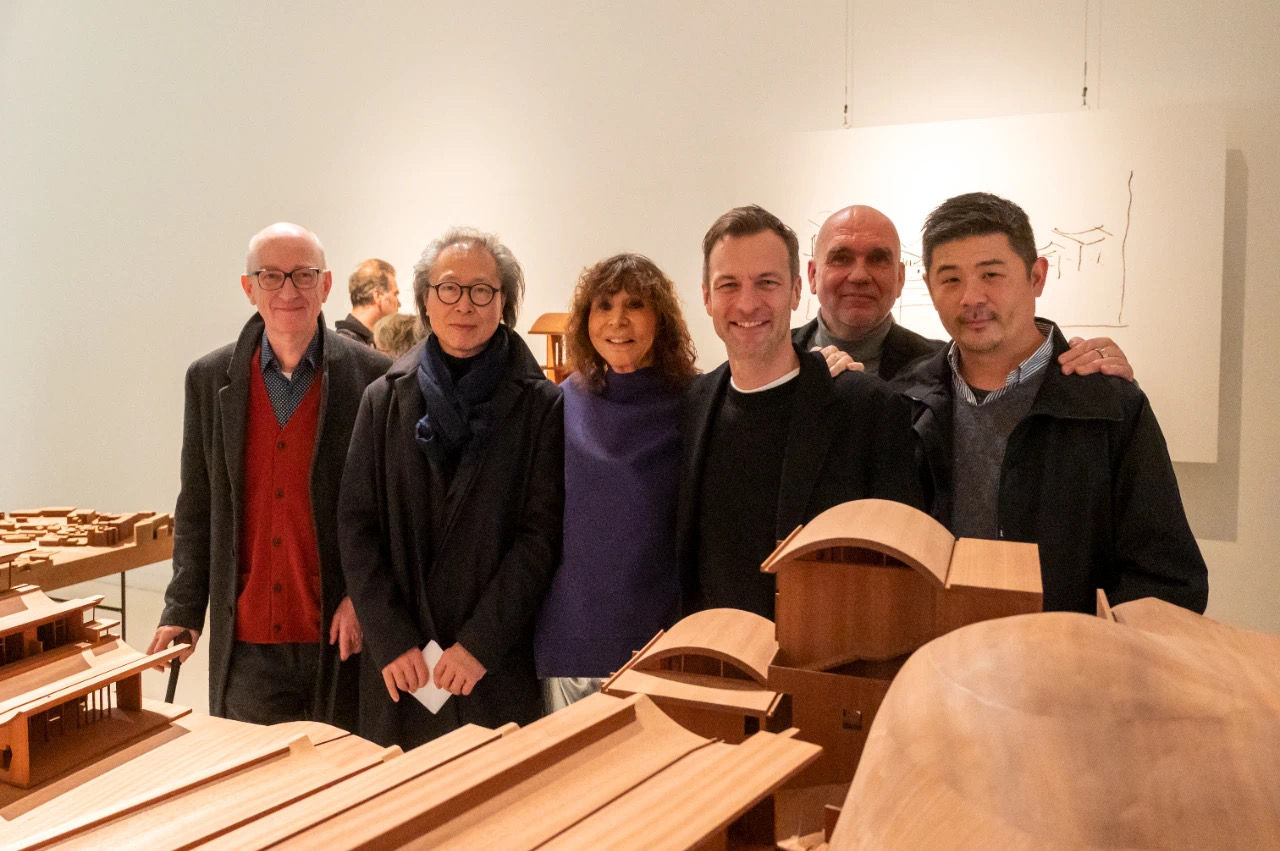
展览由德国著名建筑史学家Eduard Kögel博士担任策展人、纽约现代艺术博物馆的Philip Johnson首席策展人Martino Stierli先生任学术嘉宾。上百位来自欧洲建筑、艺术、学术等相关各界人士出席了开幕活动,展览现场欣赏探讨气氛热烈,成为新年伊始Aedes的首场建筑文化盛事。
The exhibition is curated by the famous German architectural historian Dr. Eduard Kögel, and Mr. Martino Stierli, Chief Curator for Architecture and Design, Museum of Modern Art, New York, serves as the academic guest. Hundreds of people from European architecture, art, academia and other related fields attended the opening event. The atmosphere of the exhibition was enthusiastic, making it the first architectural cultural event of Aedes at the beginning of the new year.
在展览的开幕论坛上,Aedes总监Hans-Jürgen Commerell先生首先致了欢迎辞。他自1999年Aedes的初访中国及为中国当代建筑举办的首个展览“土-木”追溯起,回顾了Aedes与中国当代建筑界长达四分之一世纪的友情,不仅表达了对这份情谊的珍视,更有对中国建筑、文化及其变化发展的强烈兴趣。Commerell先生尤其强调了对朱锫建筑作品的关注,表示在当下世界当代要求与传统背景共存的条件下,朱锫基于东方自然哲学且富于诗意的建筑思想及设计理念方法,对当代西方建筑极具启发,也是Aedes七年来第二次对他的作品进行关注的聚焦所在。
At the opening forum of the exhibition, Mr. Hans-Jürgen Commerell, Director of Aedes, first delivered a welcome speech. He traced back to Aedes’ first visit to China in 1999 and the first exhibition “TU-MU” held for Chinese contemporary architecture. He reviewed the quarter-century friendship between Aedes and the Chinese contemporary architecture community, expressing not only the value of this friendship, but also the strong interest in Chinese architecture, culture and its change and development. Mr. Commerell particularly emphasized his attention to Zhu Pei’s architectural works, saying that in the current world where contemporary requirements and traditional backgrounds coexist, Zhu Pei’s poetic architectural thoughts and design concepts and methods based on Eastern natural philosophy are extremely inspiring to contemporary Western architecture. This is the second time Aedes has paid attention to his works in seven years.

其后,本次展览的策展人Eduard Kögel博士对展览做了简要的介绍,他从建筑史学家的角度,回溯梳理了中国与欧洲当代建筑交流启发的历史,将朱锫的建筑作品放在中国当代建筑发展史的坐标中进行了阐述。在他看来,朱锫是一位敏感的翻译家,运用诗意的想象力对植根于传统中国的人与自然和谐相处的历史哲学思想所进行的反思、以及将这种来自传统的建筑经验和艺术精神融入到当代空间解决方案中的尝试是极为可贵的,由此所创造出的一种诗意的当代美学体验不仅为传统与当代定义了一种新的关系,更在实践层面以批判性的感性对抗着城市商业扩张所带来的平庸。
Afterwards, the curator of this exhibition, Dr. Eduard Kögel, gave a brief introduction to the exhibition. From the perspective of an architectural historian, he reviewed the history of the exchanges and inspirations of contemporary architecture between China and Europe, and placed Zhu Pei’s architectural works in The coordinates of the development history of contemporary Chinese architecture are explained. In his view, Zhu Pei’s reflection on the historical and philosophical thought of the harmonious coexistence of man and nature rooted in traditional China, and his attempt to integrate this traditional architectural experience and artistic spirit into contemporary space solutions are It is extremely valuable. The poetic contemporary aesthetic experience created not only defines a new relationship between tradition and contemporary times, but also uses critical sensibility to combat the mediocrity brought about by urban commercial expansion on a practical level.
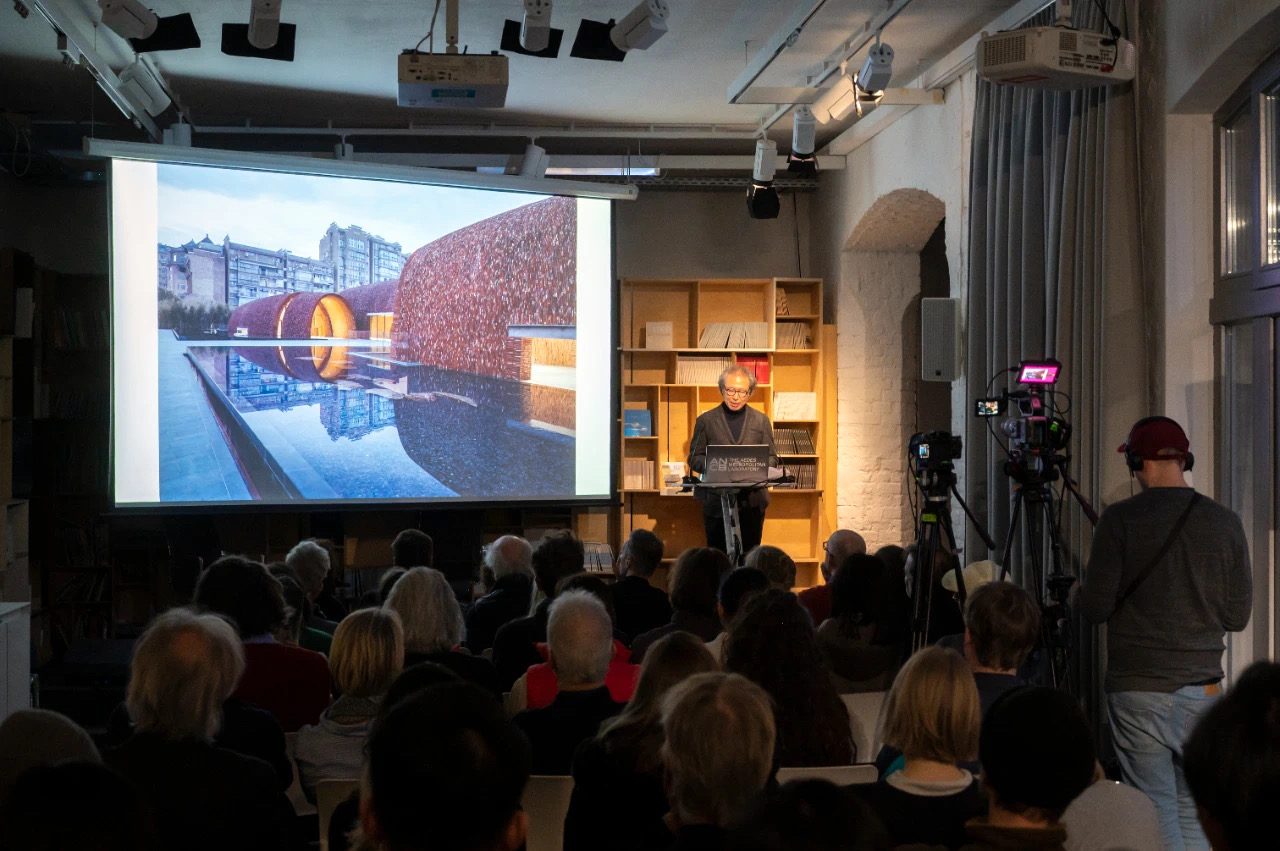
随后,建筑家朱锫先生本人结合本次展览展出的作品,对其所体现的“自然建筑”哲学做了进一步的阐释。“自然建筑”是朱锫基于文化视角对自然山水和人类建造文化的一种感悟,一方面是建造诗学,另一方面也是对全球气候变化和地域文化断裂这两个人类面临的共同挑战所给予的源于东方自然哲学的一种回应。它所探究的是建筑背后的建构法则,寻求一种人、自然和文化的一种血缘关系,其最终目标是探索人在天地间的诗意栖居。
Subsequently, the architect Zhu Pei himself combined with the works exhibited in this exhibition to further explain the philosophy of “Architecture of Nature” embodied in it. “Architecture of Nature” is Zhu Pei’s perception of natural landscape and human construction culture from a cultural perspective. On the one hand, it is construction poetics, and on the other hand, it is a response rooted in traditional Eastern natural philosophy to the immense challenges of “global climate change” and “cultural fragmentation” that humanity faces today. It explores the construction principle behind architecture, seeks a kinship between people, nature and culture, and its ultimate goal is to explore people’s poetic residence between heaven and earth.
“根源性”与“创造性”是“自然建筑”从理论到实践的双重路径,一方面,挖掘根源,建筑可以根植于某种特定的气候和文化土壤;另一方面,创造性的态度让建筑可以塑造开放的体系, 容纳很多新的可能,创造新的经验。具体而言,“自然建筑”提出了审视建筑的五个维度,分别是:1.坐相、2. 结构与形式、3. 海绵建筑、4. 穴与巢、5. 不完整的完整性。它们不仅从建造、技术的角度,更是从文化的视野揭示传统文化与当代建筑创作之间深层的血缘关系。而这种深层关系所折射出的是我们看待人、自然与传统的态度,在建筑日趋主题乐园化-商品化两极分化的当下,保持一种尊重自然、传统与人本身的历史观显得尤为重要。
“Rootedness” and “Creativity” form a dual path for Architecture of Nature, encompassing both theory and practice. ” Rootedness ” allows architecture to be deeply rooted in specific climates, geographic environments, and regional cultures. Meanwhile, ” Creativity ” functions as an experimental creative process, shaping an open architectural system that embraces new possibilities and generates novel experiences. Specifically, “Natural Architecture” proposes five dimensions for examining architecture, which are: 1. Site and Orientation, 2. Structure and Form, 3. Sponge Architecture, 4. Cave and Nest, 5. Incomplete Integrity. They not only reveal the deep kinship between traditional culture and contemporary architectural creation from the perspective of construction and technology, but also from the perspective of culture. What this deep relationship reflects is our attitude towards people, nature and tradition. At a time when architecture is becoming more and more polarized between theme parks and commercialization, it is particularly important to maintain a historical view that respects nature, tradition and people themselves. important.
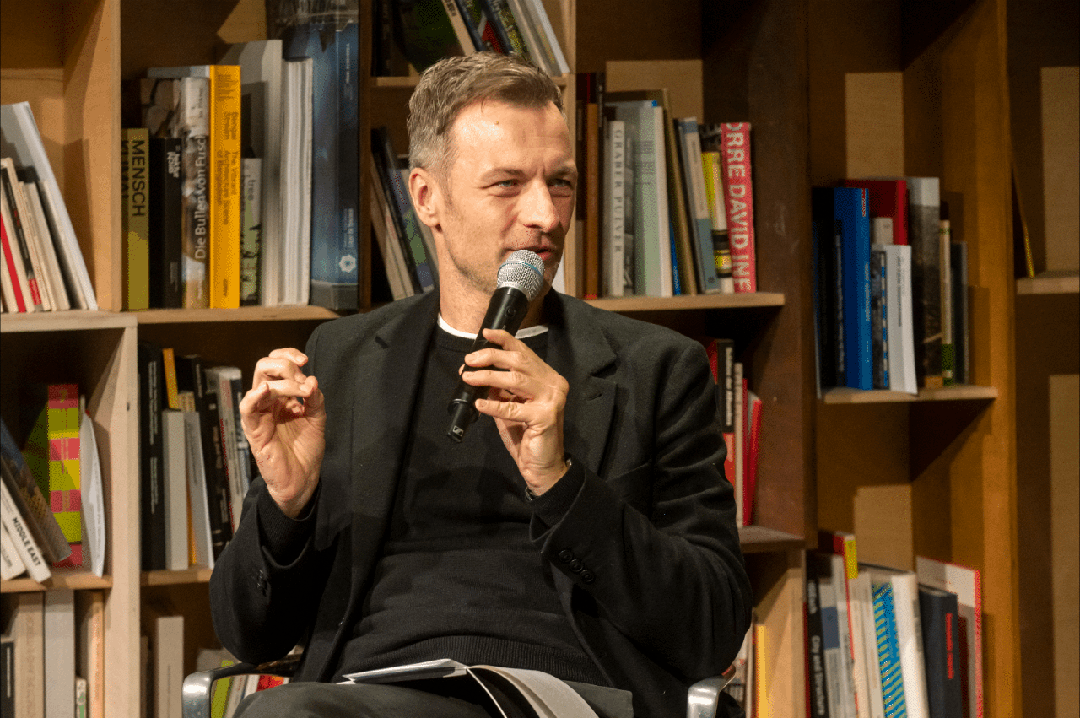
最后,自美国远道而来的纽约现代艺术博物馆策展人Martino Stierli先生与朱锫先生以对谈的形式对展览作品及背后的思想进行了深刻的评论与深入的交流。作为一位资深的建筑艺术策展人,Stierli先生作为MoMA历史上首个中国建筑展-“中国新建筑展 Recent Architecture from China”的策展人,对中国当代建筑的发展有着自己深刻的研究和独特的认知。他专业而细腻地从朱锫建筑创作背后的哲学思想,以及建筑空间体验、结构表现、材料等多方面就展出作品进行了提问和交谈,随着问答的深入,“自然建筑”的思想与意义也得以进一步显现,尤其对于西方视角的观者而言,源自东方与自然传统和谐共生的理念、建筑因人与自然的共同参与而得以完成和圆满的思想具有极大的启发性;另一方面从建筑空间体验的角度,在朱锫的作品中以当代语言诠释出了中国古典园林的精神与意蕴,正如展览标题所凝练,这种基于理性建构之上的“诗意想象”,某种程度上正是“自然建筑”的艺术魅力之所在。
Finally, Martino Stierli, Chief Curator for Architecture and Design, Museum of Modern Art, New York, who came from the United States, and Zhu Pei conducted in-depth comments and in-depth exchanges on the exhibition works and the ideas behind them in the form of a dialogue. As a senior curator of architectural art, Mr. Stierli serves as the curator of the first Chinese architecture exhibition in the history of MoMA – “Recent Architecture from China”. He has his own in-depth research and unique understanding of the development of contemporary Chinese architecture. He professionally and meticulously asked and talked about the exhibited works from aspects such as the philosophical thoughts behind Zhu Pei’s architectural creations, as well as architectural space experience, structural performance, materials, etc. As the questions and answers deepened, the philosophy of “Architecture of Nature” and the meaning can also be further revealed, especially for viewers from a Western perspective, the concept of harmonious coexistence between the East and nature, and the idea that architecture is completed and perfected by the joint participation of man and nature are extremely inspiring; on the one hand, from the perspective of architectural space experience, Zhu Pei’s works interpret the spirit and implication of Chinese classical gardens in contemporary language. As the exhibition title condenses, this “Poetic Imaginations ” based on rational construction is a certain kind of “Poetic Imaginations” based on rational construction. To this extent lies the artistic charm of “Architecture of Nature”.
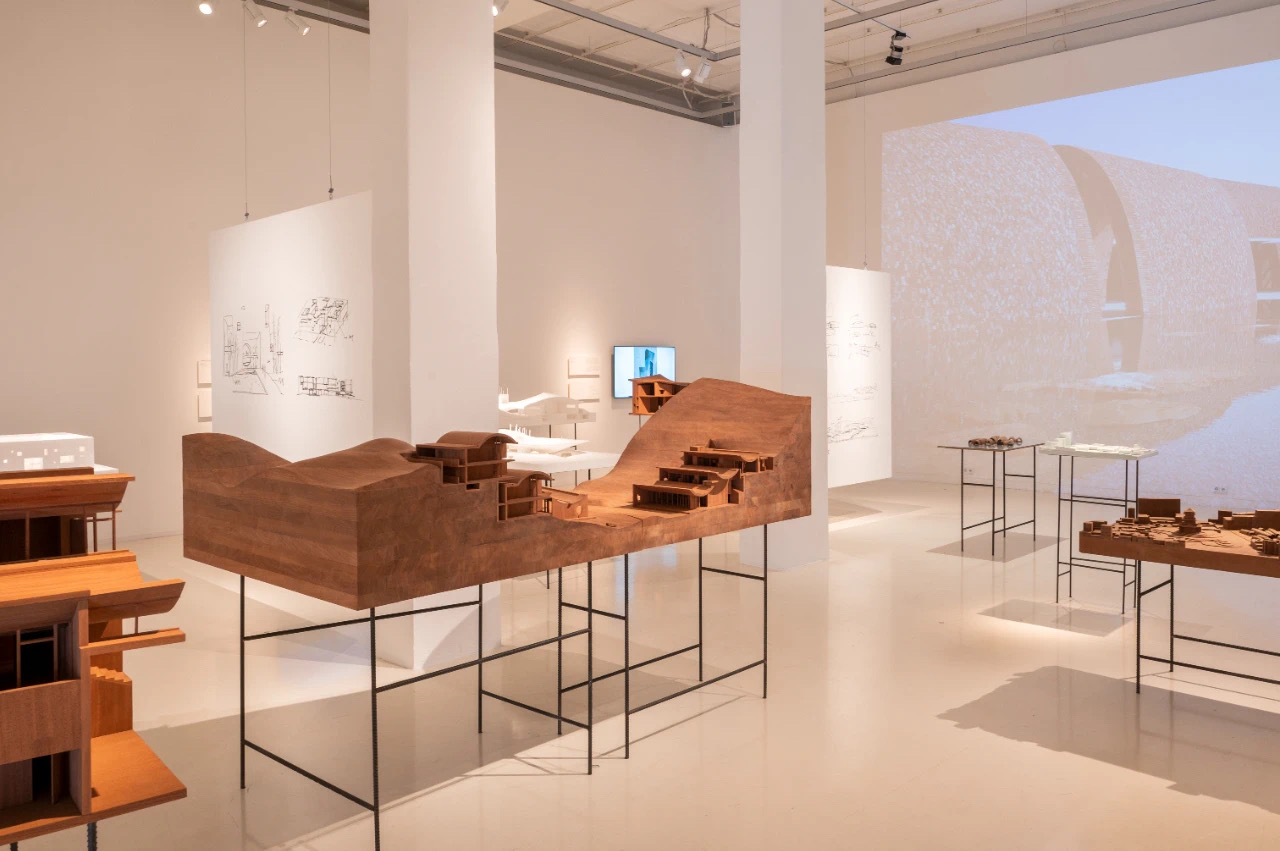

景德镇御窑博物馆 江西景德镇 2020
Jingdezhen Imperial Kiln Museum, Jingdezhen, Jiangxi, CN
景德镇作为数百年来陶瓷生产的发源地,具有着重要的历史意义。砖窑是这座城市的特色。朱锫从砖窑的传统形式中汲取灵感,将具有数百年历史的陶瓷生产文化作为设计的出发点。博物馆的功能分布在一系列独立的拱券中,这使得在施工过程中发现的考古遗迹得以融入其中。多孔的城市结构在外部和内部都具有强烈的双曲面管道和建筑材料的特征,让人联想到传统的窑炉。从旧窑中拆卸下来的老砖与新砖块混合使用在博物馆的雪茄形水平圆柱表面上,体现了在房屋建筑中重复使用窑砖的本地传统。通过对砖窑双曲面形式的复制,一组建筑群以微妙的规模坐落在了古老的瓷都之中。
As the birthplace of ceramic production for hundreds of years, Jingdezhen has important historical significance. Brick kilns are a specialty of the city. Zhu Pei drew inspiration from the traditional form of brick kilns and used the centuries-old ceramic production culture as the starting point for the design. The museum’s functions are distributed in a series of independent vaults, which allow the archaeological remains discovered during the construction to be integrated. The porous urban structure is characterized both externally and internally by strong hyperboloid pipes and building materials reminiscent of traditional kilns. Old bricks dismantled from old kilns are mixed with new bricks on the museum’s cigar-shaped horizontal cylindrical surfaces, reflecting the local tradition of reusing kiln bricks in residential buildings. By replicating the hyperboloid form of a brick kiln, a group of buildings sits on a subtle scale within the ancient porcelain capital.
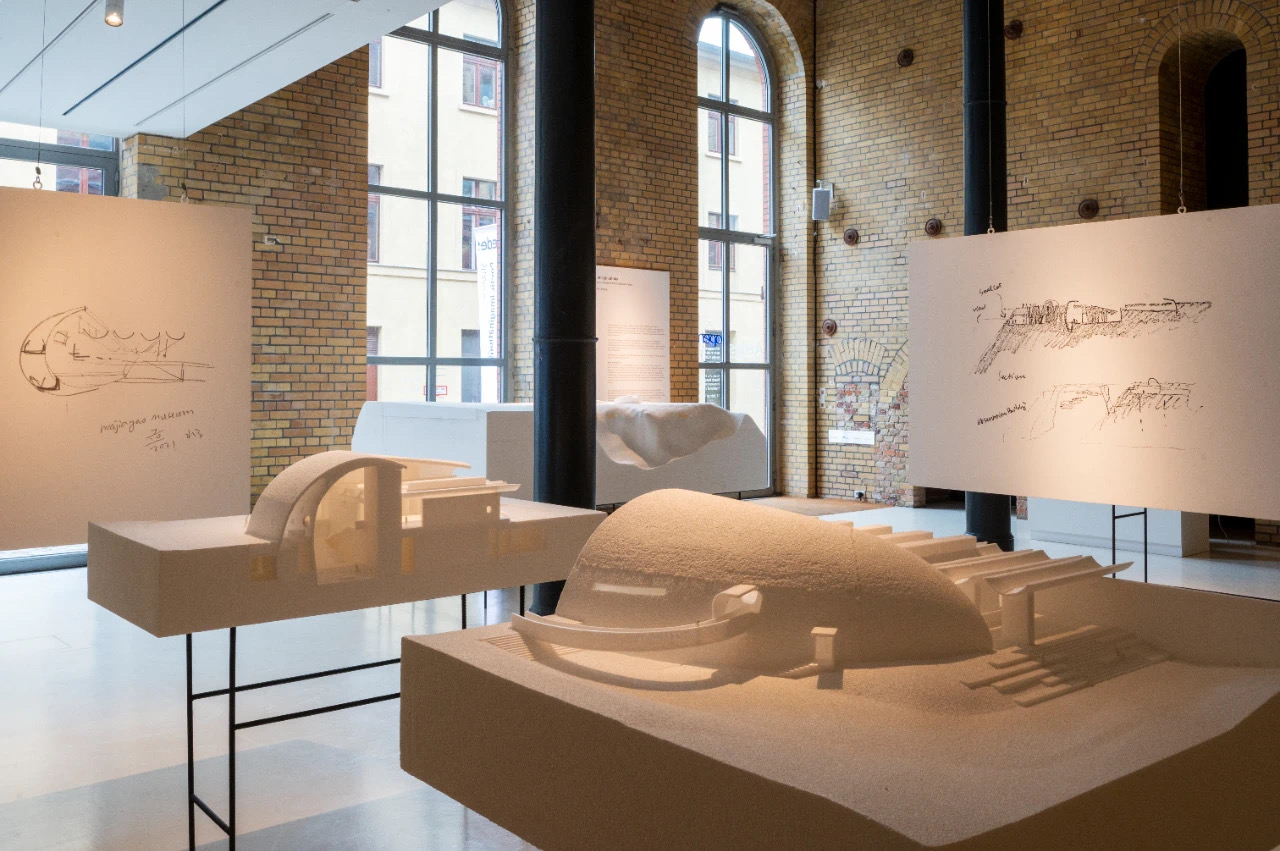
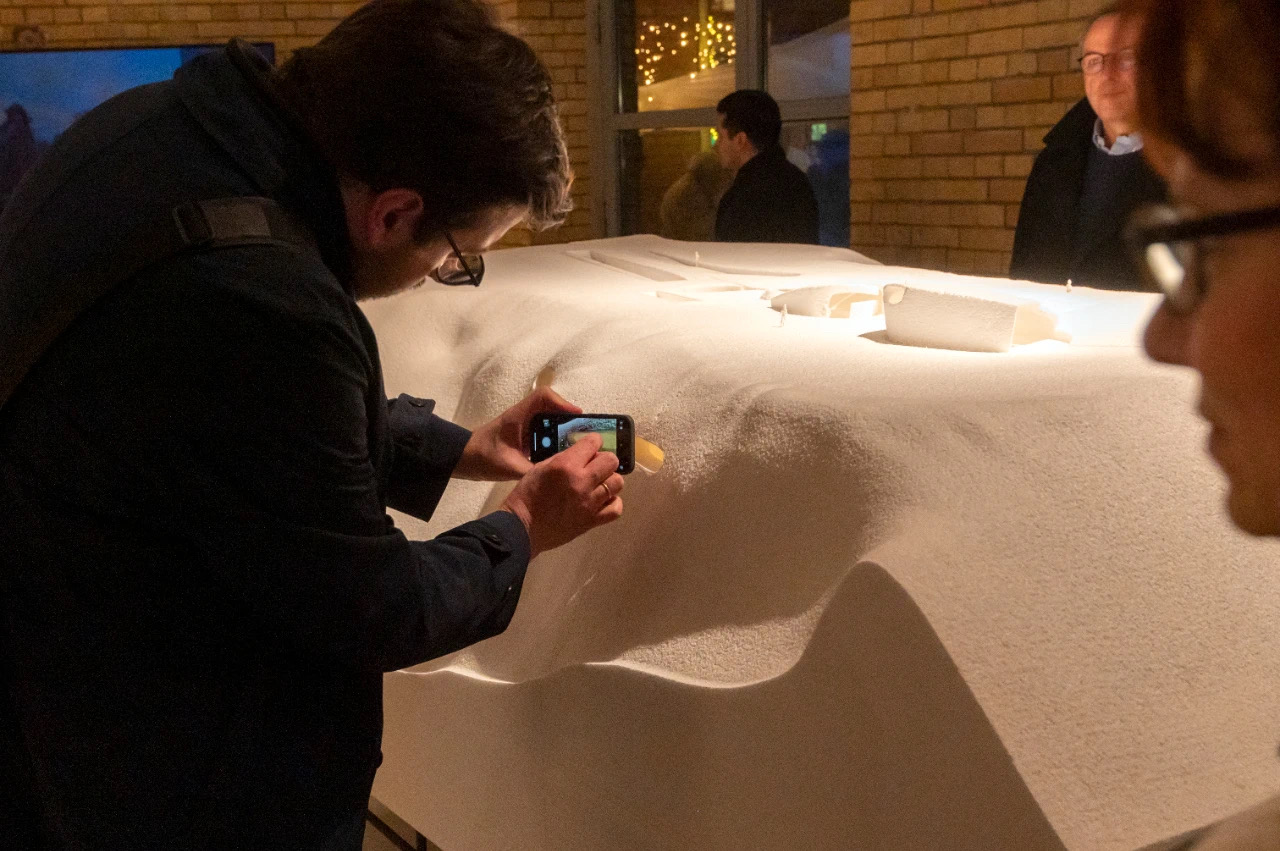
马家窑遗址博物馆与观景建筑 甘肃临洮 2018
Majiayao Ruins Museum and Observatory, Lintao, Gansu, CN
100 年前,瑞典考古学家约翰-贡纳尔-安德森(Johan Gunnar Andersson)在甘肃省临洮县的巴马峪峡谷发现了新石器时代马家窑文化(公元前 3500-2800 年)的证据。朱锫为之设计了一座博物馆和一座观景建筑,旨在鼓励当地旅游业的发展。第一阶段为峡谷北侧的博物馆,观景台将在第二阶段建在峡谷南面的山丘台地上,登临即可俯瞰遗址(和博物馆)。为使博物馆建筑的可见影响降到最低,设计将一半的空间位于地面以下;弧形立面中楼梯的双层墙壁上的椭圆形开口,突出了空间的洞穴特征;与当地砂土混合的夯实混凝土材质也是当地地域特征的显现。
100 years ago, Swedish archaeologist Johan Gunnar Andersson discovered evidence of the Neolithic Majiayao Culture (3500-2800 BC) in the Bamayu Canyon in Lintao County, Gansu Province. Zhu Pei designed a museum and an observatory to encourage the development of local tourism. The first phase is the museum on the north side of the canyon. In the second phase, the observatory will be built on the hill platform on the south side of the canyon. People can overlook the ruins (and museum) from the top. To minimize the visible impact of the museum building, the design places half of the space below ground level; oval-shaped openings in the double walls of the staircase in the curved facade, highlighting the cavernous character of the space; tamped concrete mixed with local sand The concrete material is also a manifestation of local regional characteristics.

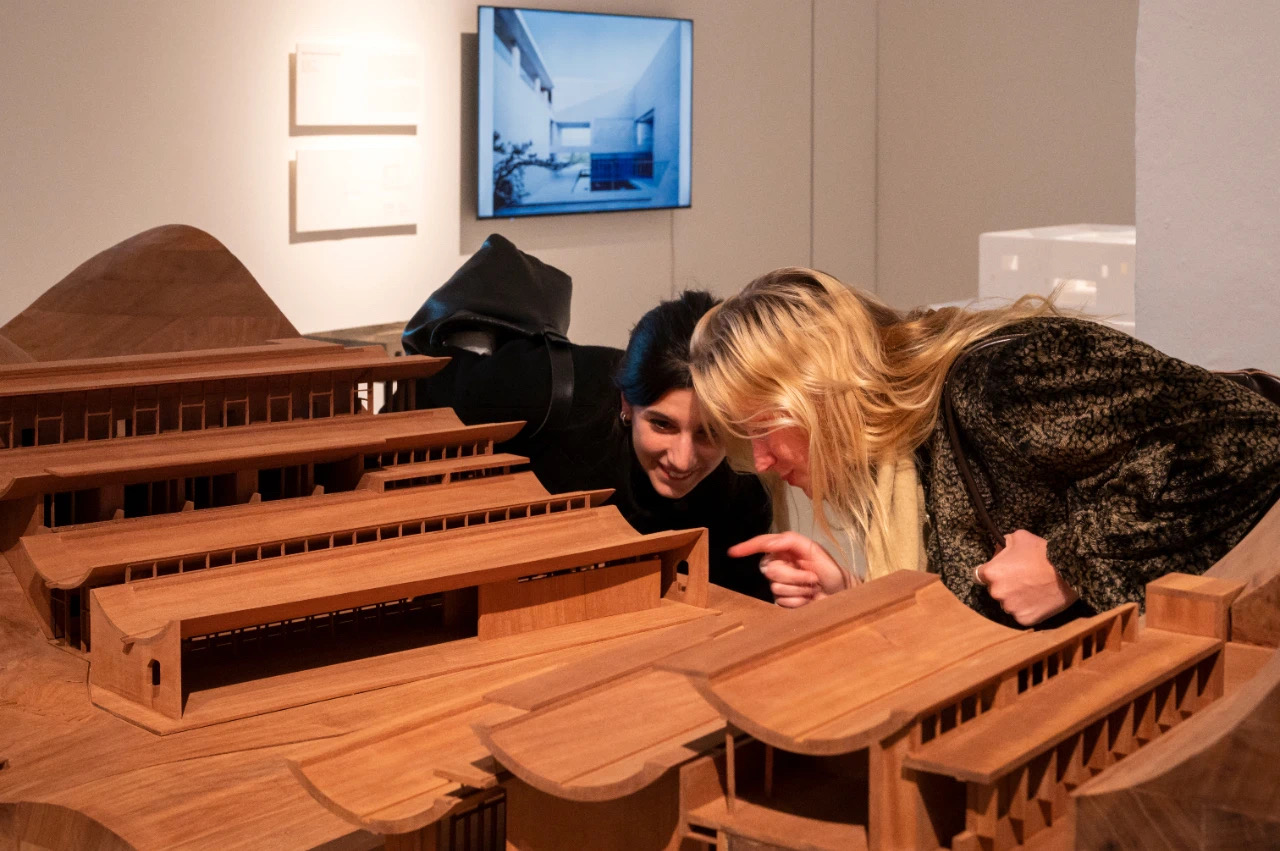
紫晶国际会舍 江西景德镇 2022
Zijing International Conference Camp, Jingdezhen, Jiangxi, CN
会舍位于江西省景德镇的市郊。朱锫说服客户,使建筑的体量与场地的地形景观环境相协调。设计方案分为 11 栋单体建筑,这种分散性使得建筑以可控的体量坐落在狭窄的山谷中,从而保持了其亲切感。建筑的表现形式以传统建筑的封闭式屋檐为蓝本,但通过增加抽象的半筒形屋顶片段(有时向上,有时向下)进行了改造。宽大的悬挑屋顶营造出一个遮蔽空间,同时也模糊了室内外的界限。公共空间中的景观植物与周围山坡上未经雕琢的茂密植被融为一体,进一步降低了建筑对景观的影响。
The conference center is located on the outskirts of Jingdezhen, Jiangxi Province. Zhu Pei persuaded the client to harmonize the building’s volume with the topography and landscape of the site. The design is divided into 11 individual buildings, and this dispersion allows the building to sit in a narrow valley with a controlled volume, thus maintaining its intimacy. The architectural expression is modeled on the closed eaves of traditional architecture, but transformed by the addition of abstract semi-barrel roof segments (sometimes pointing upwards, sometimes downwards). The wide cantilevered roof creates a sheltered space while blurring the boundaries between indoors and outdoors. Landscape plantings in the public spaces blend into the lush, uncut vegetation of the surrounding hillsides, further reducing the building’s impact on the landscape.


OCT艺术中心 山东淄博 2020
OCT Art Centre, Zibo, Shandong, CN
华侨城艺术中心位于山东省淄博市东北郊。一个中央庭院由三个展馆环绕,包括一个展厅、一个多功能厅和一个接待区,而庭院则由有机形状的草坡、松树和砾石组成,犹如盆景。从建筑结构上看,贝壳状的弧形混凝土屋顶和仿照当地传统砌筑技术的红色天然石墙占据了主导地位。独立的现浇屋顶平面以及外墙和面向庭院的墙壁上的不规则开口都体现了该建筑的独特性。宽大的屋顶悬挑提供了遮风挡雨的室外空间,可根据天气情况扩大建筑的使用面积,并将建筑内外无缝连接起来。游客在其中所体会到的是有如传统四合院中的季节与空间。
OCT Art Center is located in the northeastern suburbs of Zibo City, Shandong Province. A central courtyard is surrounded by three pavilions, including an exhibition hall, a multi-function hall and a reception area, while the courtyard is composed of organically shaped grass slopes, pine trees and gravel, like bonsai. Structurally, the shell-shaped curved concrete roof and red natural stone walls modeled on traditional local masonry techniques dominate the building. The unique character of the building is reflected in the independent cast-in-place roof plane and irregular openings in the facade and the walls facing the courtyard. Generous roof overhangs provide sheltered outdoor space, expand the building’s usable area according to weather conditions, and seamlessly connect the interior and exterior of the building. What visitors experience is the seasons and space in a traditional courtyard house.
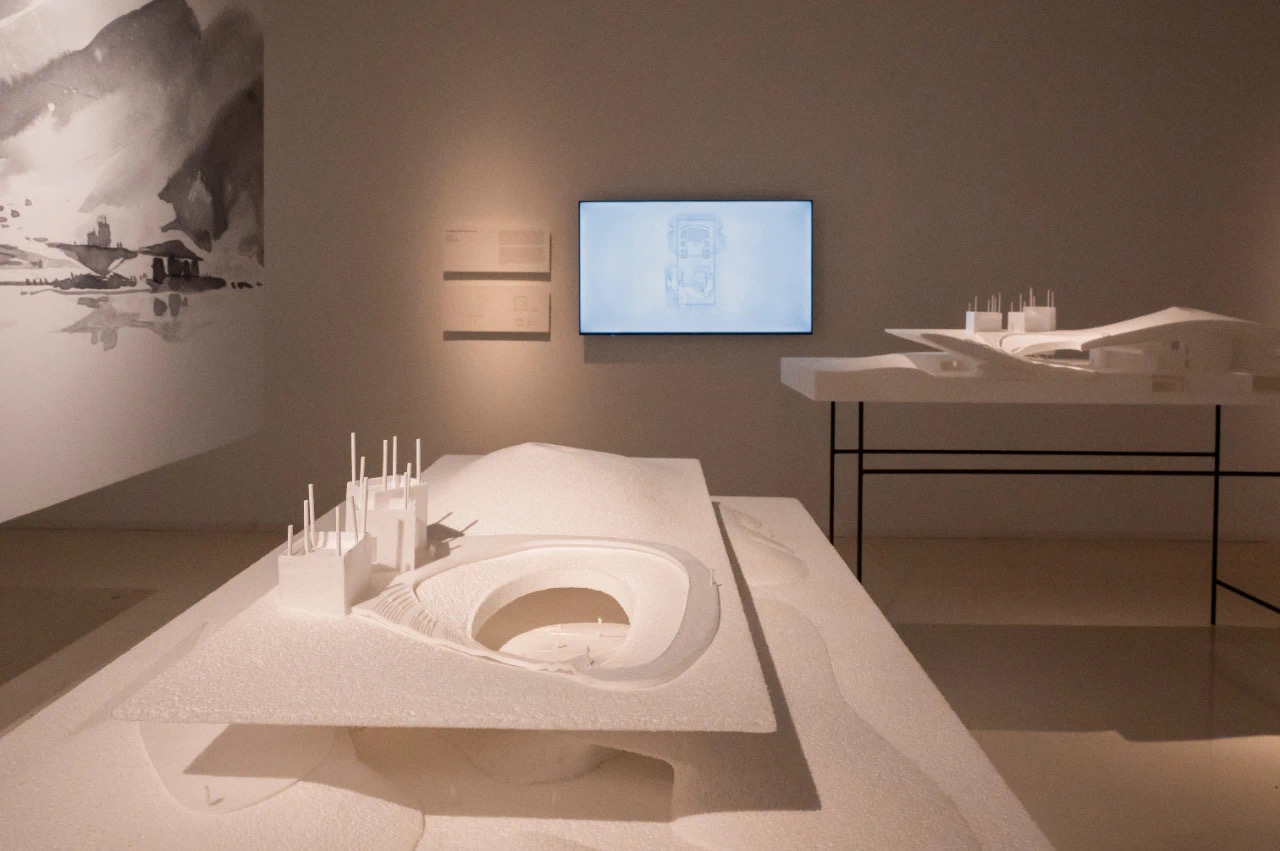
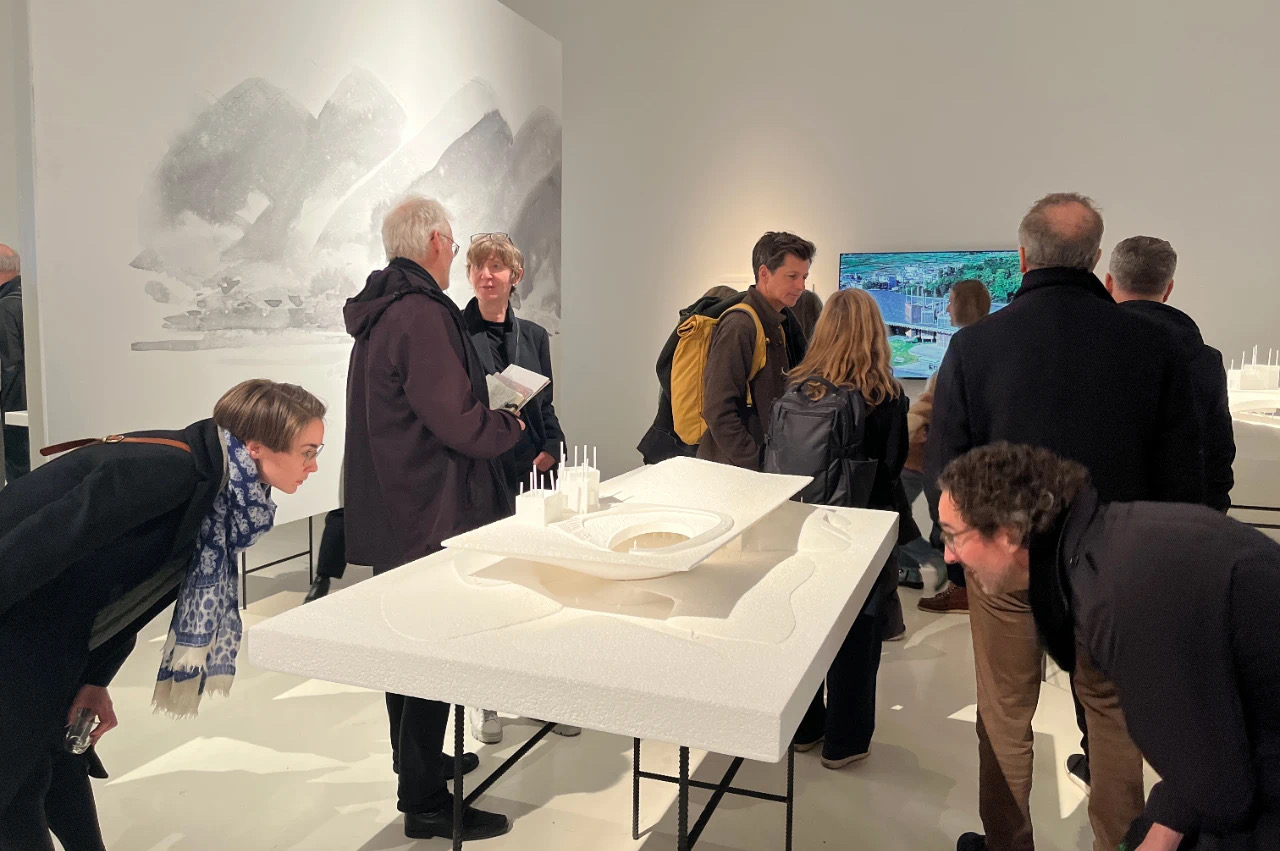
杨丽萍表演艺术中心 云南大理 2020
Yangliping Performing Arts Centre, Dali, Yunnan, CN
云南大理的表演艺术中心以舞蹈家杨丽萍的名字命名。一个巨大的水平屋顶是其最为显著的特色,覆盖着下方的人工造型景观。在冬季短暂干燥、夏季温暖多雨的亚热带高原气候中, 屋顶起到了遮阳挡雨的作用,它有如飞毯般飘浮在舞台区上空,并向下倾斜抵达对面的前院,为游客开辟出一条环形小径,使他们可以从屋顶边缘欣赏到远处的风景。屋顶由钢结构构建,钢结构的底部则溶解成一片由众多木杆构件单元拼插构成的三维立体“云”状木格,这些木格犹如多孔的云朵之垫将屋顶承托起来,与大地之间形成了一个流动的无限空间。表演空间的内部由杨丽萍亲自设计。
The performing arts center in Dali, Yunnan, is named after dancer Yang Liping. A large horizontal roof is its most striking feature, covering the artificially shaped landscape below. In the subtropical plateau climate with short dry winters and warm and rainy summers, the roof plays a role in shading from the sun and rain. It floats like a flying carpet over the stage area and slopes down to reach the opposite front yard, creating a circular path for visitors, allowing them to enjoy distant views from the edge of the roof. The roof is constructed of a steel structure, and the bottom of the steel structure dissolves into a three-dimensional “cloud”-shaped wooden lattice composed of numerous wooden pole component units. These wooden lattice are like porous cloud cushions that support the roof and connect with the earth. A flowing infinite space is formed between them. The interior of the performance space was designed by Yang Liping herself.


寿县文化艺术中心 安徽寿县 2019
Shou County Culture and Art Centre, Shou County, Anhui, CN
寿县文化艺术中心位于安徽省寿县老城区,地处同质化高楼林立的城市化区域,朱锫的设计以老城的空间特质为导向,他将狭窄的小巷、逼仄的内院和坚固的外墙转译为一个巨大的体量,在其内部则创造出了丰富的空间体验。艺术馆、文化中心、图书馆和档案馆等主要功能都可以通过一系列庭院进入。庭院内有水景、巨石、松树、竹子和砾石,这些设计安排将传统价值转化为当代的新形象。虽然从外观上看,这座文化街区显得相当激进,但其内部却提供了一个丰富的空间体验世界,与历史古城同样注重了人的尺度。
Shou County Culture and Art Center is located in the old town of Shou County, Anhui Province. It is located in an urbanized area with many homogeneous high-rise buildings. Zhu Pei’s design is guided by the spatial characteristics of the old town. He transformed the narrow alleys, cramped inner courtyards and solid outer walls into a huge volume, creating a rich spatial experience inside. Key functions such as art galleries, cultural center, library and archives are all accessible through a series of courtyards. The courtyard features water features, boulders, pine trees, bamboo and gravel, and these design arrangements transform traditional values into a new contemporary image. Although this cultural district appears quite radical from the outside, its interior offers a rich world of spatial experiences that pays the same attention to the human scale as the historic city.
由于特定原因,运输展品的船只变更航线,所有展品在开幕前一天中午才到达展厅。由衷地感谢以下所有单位及个人,让我们24小时内奇迹般地完成了这次布展。
Due to specific reasons, the ship changed its route and all exhibits arrived at the exhibition hall at noon the day before the opening. Sincere thanks to all the following organizations and individuals. It enabled us to miraculously completed the installation within 24 hours.

特别鸣谢
Acknowledgement
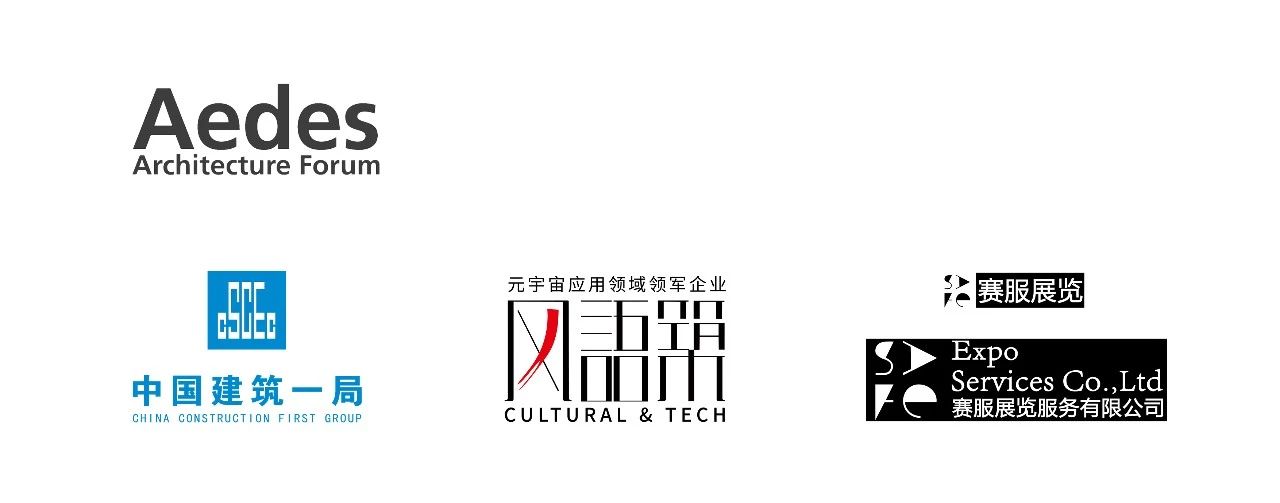
展览信息
Exhibition information
朱锫建筑设计事务所
诗意想象:建筑与传统价值观的交织
地点: 德国柏林Aedes建筑论坛 Christinenstr. 18-19, 10119 Berlin
展期:2024年2月17日-3月27日
开放时间: 周一 1-5pm, 周二-周五11.30am-6.30pm, 周日、公共假日1-5pm
项目管理:Mathias Schnell, Aedes Architecture Forum
策展人:Dr. Eduard Kögel, Berlin
设计团队:刘亦安,汤沄,王思琦,王俊棋
联合主办机构:上海风语筑文化科技股份有限公司
展览支持:
中国建筑一局(集团)有限公司,中建一局华江建设有限公司,
广州赛服展览服务有限公司
Studio Zhu Pei
Poetic Imagination: Interweaving Architecture With Traditional Values
Location: Aedes Architecture Forum Christinenstr. 18–19, 10119 Berlin, Germany
Exhibition period: February 17-March 27, 2024
Opening hours: Monday 1–5pm, Tuesday-Friday 11.30am–6.30pm, Sunday and public holidays 1–5pm
Project management: Mathias Schnell, Aedes Architecture Forum
Curator: Dr. Eduard Kögel, Berlin
Design team: Liu Yian, Tang Yun, Wang Siqi, Wang Junqi
Collaborative Organizing Institute: Shanghai Fengyuzhu Culture Technology Co., Itd.
Exhibition Support:
China Construction First Group Corporation Limited, Huajiang Construction CO., LTD of China Construction First Group.
Guangzhou Safe Expo Services Co, Ltd.